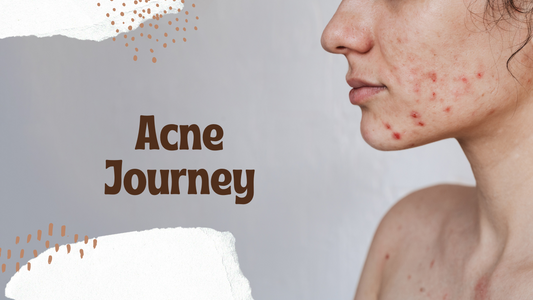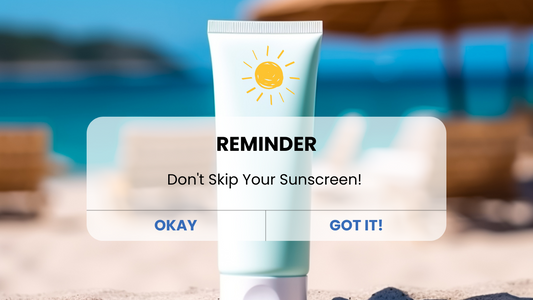Discover how to choose the perfect sunscreen for your skin type. Learn about SPF, UVA/UVB protection, ingredients to look for, and tips for daily sun safety in this ultimate guide.
Index
Understanding Sunscreen: Why It’s Essential | The Science Behind Sun Protection | Myths and Misconceptions About Sunscreen | Decoding SPF | Broad-Spectrum Protection | Common Mistakes People Make | Types of Sunscreen | Choosing the Right Sunscreen Based on Your Skin Type | Sunscreen Formulations | Water-Resistant Sunscreens | How to Apply Sunscreen | Beyond Sunscreen | Eco-Friendly Sunscreens | Final Thoughts | FAQ | Glossary | References
Understanding Sunscreen: Why It’s Essential
According to the Skin Cancer Foundation, using sunscreen daily can reduce your risk of developing squamous cell carcinoma by about 40% and melanoma by 50%. Yet, many of us skip this simple but powerful step in our routines.
Sunscreen isn't just another step in your skincare lineup—it's your frontline defense against UV-induced skin damage. From preventing sunburn to fighting early signs of aging and reducing the risk of skin cancer, daily SPF application is a must.
The Science Behind Sun Protection
Sunscreen works by either absorbing, reflecting, or scattering ultraviolet (UV) radiation. There are two types of UV rays you should be aware of:
UVA Rays
These penetrate deeper into the skin, damaging collagen and elastin. They cause fine lines, wrinkles, and pigmentation issues.
UVB Rays
These primarily affect the skin's surface, leading to sunburn. Overexposure can contribute to skin cancer.
Myths and Misconceptions About Sunscreen
- “Sunscreen is only needed on sunny days.” → False! UV rays penetrate clouds and windows.
- “Higher SPF means all-day protection.” → False! Reapply every 2–3 hours.
- “Darker skin tones don’t need sunscreen.” → False! Melanin doesn't block all UV rays.
Decoding SPF: What Does It Really Mean?
SPF 30 vs. SPF 50
Sun Protection Factor, or SPF, is often the first thing people look for on a sunscreen label, but what does it really mean? SPF is a measure of how well a sunscreen will protect your skin from UVB rays, the kind of radiation that causes sunburn and contributes to skin cancer. An SPF 30, for instance, will allow you to stay in the sun 30 times longer than if you were unprotected. However, it's crucial to understand that no sunscreen can block 100% of UVB rays.
Broad-Spectrum Protection: The Key to Skin Safety
Why Broad-Spectrum Matters
SPF measures UVB protection only. Look for "broad-spectrum" to ensure you’re also shielded from UVA rays that accelerate aging and cause pigmentation.
How to Check If Your Sunscreen Protects Against UVA/UVB
- PA Ratings: PA+, PA++, PA+++, PA++++ — more "+" means more UVA protection
- Ingredients: Zinc oxide, titanium dioxide (mineral); Avobenzone (chemical)
Common Mistakes People Make When Choosing Sunscreen
- Picking the wrong SPF
- Using expired products
- Skipping spots like ears, neck, and hands
- Not reapplying post swimming/sweating
Types of Sunscreen: Physical vs. Chemical
1. Physical Sunscreen (Mineral Sunscreen)
- How It Works: Reflects UV rays
- Best For: Sensitive skin, kids
- Key Ingredients: Zinc oxide, titanium dioxide
- Pros: Immediate effect, less irritation
- Cons: May leave a white cast
2. Chemical Sunscreen
- How It Works: Absorbs UV rays and converts them into heat
- Best For: Daily wear
- Key Ingredients:
- Avobenzone: UVA protection
- Oxybenzone: Broad-spectrum (may irritate sensitive skin)
- Octinoxate: UVB absorber
- Pros: Lightweight, blends easily
- Cons: Needs 20-30 min to activate
3. Newer Filters
Tinosorb is the trade name for two related compounds: Tinosorb S (Bemotrizinol) and Tinosorb M (Bisoctrizole). These filters are known for their broad-spectrum protection and stability compared to some older sunscreen ingredients.
Benefits of Tinosorb
- Broad-Spectrum Protection: Tinosorb provides excellent protection against both UVA and UVB rays, reducing the risk of sunburn, skin cancer, and premature aging.
- Photostability: Both Tinosorb S and M are remarkably stable under UV exposure, which means they maintain their effectiveness longer without breaking down.
- Skin Compatibility: These filters are less likely to cause skin irritation compared to some traditional sunscreen ingredients, making them suitable for sensitive skin.
- Environmental Impact: Tinosorb is considered to have a lower environmental impact compared to certain other chemical filters like oxybenzone, which have been associated with coral reef damage.
Best Choice for Sensitive Skin
For sensitive skin, the best choice of sunscreen would be a mineral sunscreen that is gentle and specifically formulated to avoid irritation. Look for a product that contains zinc oxide and/or titanium dioxide, as these ingredients are known to provide broad-spectrum protection by physically blocking UV rays. Additionally, ensure the sunscreen is labeled as hypoallergenic and fragrance-free to minimize the risk of allergic reactions. A good example would be a sunscreen infused with calming and hydrating ingredients such as aloe vera, squalane, or ceramides.
Choosing the Right Sunscreen Based on Your Skin Type
- Oily Skin: Gel-based, oil-free with niacinamide or zinc oxide
- Dry Skin: Creams with ceramides, glycerin, squalane
- Sensitive Skin: Fragrance-free mineral formulas
- Combination Skin: Hybrid lotions with hyaluronic acid
- Normal Skin: Any SPF 30+ with antioxidants
- Pigmented Skin: Tinted sunscreens with SPF 50+
Sunscreen Formulations: Which One Suits You Best?
- Creams: Dry skin
- Gels: Oily or acne-prone skin
- Sprays: Easy reapplication (rub it in!)
- Sticks: Targeted use (ears, lips)
- Oils: For dewy finish, not for acne-prone skin
Water-Resistant Sunscreens: Do You Need One?
When snorkeling or diving in India’s ecologically famous destinations like the Andamans, Goa, or Lakshadweep, opting for non-nano mineral sunscreen (zinc oxide or titanium dioxide with particles larger than 100nm) is critical for reef protection, as nano or micronized particles—often labeled “invisible” or “sheer”—are ingested by corals, causing DNA damage and bleaching, while chemical sunscreens with oxybenzone or octinoxate worsen marine degradation. Though non-nano formulas may leave a temporary white cast, they’re the safest choice for India’s reefs, which sustain biodiversity and coastal communities.
What It Means
Water-resistant = effective for 40-80 minutes in water.
When to Use
Beach days, workouts, outdoor events.
Reapplication Tip
Reapply after towel-drying.
How to Apply Sunscreen Correctly for Maximum Protection
- Two-Finger Rule: Use two fingers’ worth for face and neck
- Shot Glass Rule: 1 oz for full body
- Apply Early: 20-30 minutes before sun exposure
- Don't Miss: Ears, eyelids, feet, back of hands
Beyond Sunscreen: Other Sun Protection Strategies
- UPF Clothing: Look for UPF 50+
- Stay Shaded: 10 AM to 4 PM
- Sunglasses: UV 400-rated to protect your eyes
Eco-Friendly Sunscreens: What to Look For
- Reef-Safe: Avoid oxybenzone & octinoxate
- Sustainable: Choose brands with biodegradable packaging
Final Thoughts: Your Ultimate Sunscreen Checklist
- Broad-Spectrum (UVA & UVB)
- SPF 30+ for daily, SPF 50+ for outdoors
- Water-Resistant when needed
- Matched to your skin type
- Always check the expiry date
Daily SPF is your best defense against premature aging and sun damage. Make it a habit, not a hassle. With every customized formulation prescribed at Formial to repair or treat your skin, it's essential to use a sunscreen best suited for you. Take a free consultation to receive personalized recommendations.





